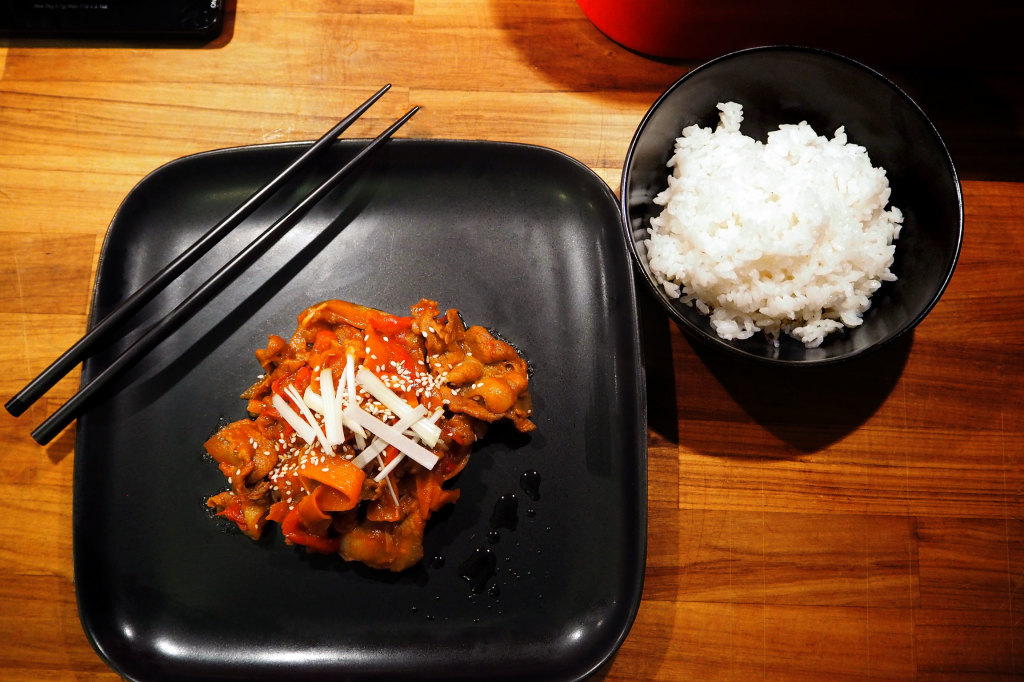Jeyuk-bokkeum (제육 볶음), or Korean spicy stir-fried pork

Bokkeum in korean simply refers to stir-fried food. The verb form of the word is “bokkda” (볶다) which means “cooking dried ingredients over heat.” Nowadays the use of the word is not limited to dry stir-fried food, but also means stir-fried foods in thick sauce. Jeyuk-bokkeum (제육볶음) or “pork-bokkeum” (Korean spicy stir-fried pork) is what this recipe is all about. If you just get a hold of the ingredients, the actual cooking is quite quick, simple, and amazing! The most distinct flavour in here, the one that really makes me think of Korean food, comes from the flavoursome red paste called gochujang. It’s made from soybeans that ferment for up to eight months on traditional elevated stone platforms, called jangdokdae. The beans are then mixed with glutinous rice, red chili and salt. That paste, in turn, then lays under the sun to really get those yeast bacteria working. The result is a dark red savory and pungent paste.
Get a hold of good ingredients, and don’t cook on too high heat, and it’s impossible for you to fail with this wonderful stew like dish. The only risky part is the rice. If you don’t cook it properly, you’ll either end up with a chewy porridge or with western-style boiled rice impossible to eat with chop-sticks. This is why I’ll be very specific on the rice cooking instructions, and I don’t expect you to own a rice-cooker. So I’m talking Korean style rice on a normal household stove.
The quantities bellow yield about 4 people depending on how hungry you are.
For the rice you’ll need
- About 120 ml of rice per person. Use a short grain rice, often simply marketed as “sushi rice” outside of Asia. The variety is often Koshi or Koshihikari, but even American short grain Calrose rice works. If you only have long grain rice, forget it.
- Fresh water in a quantity 33% higher than that of the rice. So if you’re making 100 ml or rice, you need around 133 ml of fresh water. If you’re making 300 ml of rice, you’ll need 400 ml of water. And so on.
- A pot or saucepan with a lid
- Some time.
Ok, so this is how you do the rice…
- Wash the rice a couple of times in a bowl with a good amount of cold water. The first time, the water will be all milky white. That’s starch. Get it out of there. Pour in fresh water, and wash the rice again. When you clearly see the grains on the bottom of your bowl, that’s when you’re done washing the rice. It takes about 2-3 rounds.
- Put the rice in your pot, cover it with cold water (1,33 times the volume, remember?), and let it sit there. It shall soak for 45 minutes! Don’t rush this, it’s a very important step!
- Set your stove to high heat, but stand by every second of this step. As soon as the water starts boiling, put on a lid and turn down the heat to low. If you have neither a gas stove nor an induction stove, then move the pot to another part of the stove top. The old metal stoves take too long to cool down, meaning your rice will boil for too long instead of simmering on low.
- After about 15 minutes, your rice is done. It can take a little longer, or a little shorter, depending on the rice type and quality. This rice will go perfectly alongside your spicy stir-fried pork.
For the stew you’ll need
- About 700 grams of pork belly. Raw, meaning you don’t want it cured nor smoked. If you have access to a butcher, and he only sells the pork belly in whole slabs, ask him to cut it into thin slices for you He has a machine and will do it in no time, whereas you’ll have to painstakingly cut it with a knife. You’re going to have a bad time.
- 1 large red bell pepper
- 1 large onion
- 2 cloves of garlic
- 1 large carrot
- A piece of leek (I’m using the light green part, the one between the white top and the dark green “leaves”)
- 3 tbsp of gochujang (the Korean red paste)
- 2 tbsp sugar
- 3 tbsp of rice vinegar
- 3 tbsp dark soy sauce
- a couple of dashes of sesame oil
- a couple of pinches of sesame seeds
Put your Korean spicy stir-fried pork together
- Cut all the vegetables into thin slices. Cut them along the long side, Korean style. Well, actually very East and Southeast Asian style.
- Cut the thinly sliced pork belly into smaller pieces. I would say an average length of sliced pork belly, should be cut in about 3. If you didn’t ask your butcher to pre-slice the pork belly for you, and you didn’t find sliced raw pork belly in the supermarket, you’re up for a long evening of thinly slicing meat. But it can be done.
- Mix up the gochujang, soy sauce, vinegar and sugar.
- Put meat and vegetables into the sauce, and mix it all up. Make sure you cover every side of every pork belly slice and vegetable piece in there, with the sauce. And then let it marinate for a while. At least that’s what people will tell you. I’ve noticed no difference whether I let it marinate or not. Your call.
- Transfer it all into a cold pan, and slowly heat it up to medium heat. You don’t want any crunchiness here. Let the fat from the pork belly slowly melt and mix up with the sauce and all. Make sure to stir often. When the sauce in the bottom of the pan is no longer liquid, but rather a thick paste very small in quantity, it means the excess liquid has evaporated and the fat is stuck to the vegetables and everything is just wonderful.
- Put it on a plate, and drip sesame oil on top of your stew.
- Slice the leek, put it on top together with some sesame seeds.
- Finally, serve the Korean spicy stir-fried pork with your perfectly cooked rice
Enjoy!

